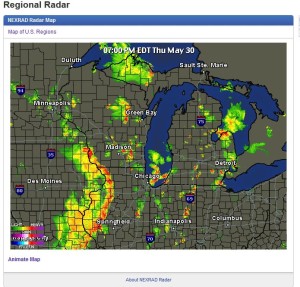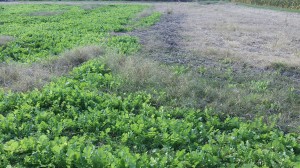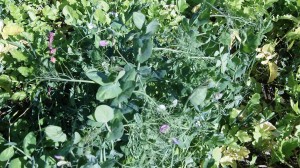The following was originally posted on May 27, 2011 when the Eastern Corn Belt was suffering with severe flooding and wet conditions. In 2013 the Upper Midwest – especially Iowa, Minnesota, and Wisconsin – is flooded and wet. Many farmers are considering taking the crop insurance for prevented planting. Even if it would stop raining – which does not appear will happen anytime soon – many farmers will not be in their fields for two weeks. While locations are different, the recommendations below still apply. Please keep the farmers in the Upper Midwest in your prayers; they need it!
For other options that might include growing cover crops for forages click here.

In 2010 there were wet spots in fields that were never planted, so some ingenious farmers planted cover crops in those spots after they dried out. Now in 2011 there are several entire fields that may not be planted to cash crops at all. I have heard from two friends in Ohio that are working on plans to help northwest Ohio farmers know what to use on their prevented acres.
Maybe this is not an issue where you live. I hope you never have to face a spring like this year in the Eastern Corn Belt, where many producers in Ohio, Indiana, Illinois, and Michigan are struggling to get their crops in the ground. The forecast is for many more days of rain to finish out the month of May.

For prevented planting the cover crops may not be harvested until after November 1st.
So what are the options for planting cover crops in the prevented planted fields? Below I will list the options with a few of their benefits and also some disadvantages.
Oats
Advantages
- Provides erosion control
- Scavenges nitrogen
- Grows a deep and fibrous root mass
- Promotes mycorrhiza growth
- Quick to establish
- Relatively inexpensive
- Can be broadcast and lightly tilled in
- Can be added to other cover crops to add additional value
- Can spray with broadleaf herbicides if necessary to control weeds
Disadvantages
- While they provide cover and decent root growth they do not provide additional nitrogen to the soil (at the most it would be very minimal)
- Best to use seed oats vs. bin run oats for optimum value
- If planting wheat after oats there may be some “grass after grass” issues (I’m not confident this will be a problem and would welcome comments)
Field Peas or Austrian Winter Peas

Advantages
- Can provide 60-120 # nitrogen/acre (excellent if following with wheat in the fall)
- Can be broadcast and lightly tilled in (1″ or deeper)
- Can be added to other cover crops to add additional value (add to oats)
- Can spray with broadleaf herbicides if necessary to control weeds
Disadvantages
- Slower to establish than oats
- More costly than straight oats
- Seed MUST be inoculated at the time of planting
Crimson Clover
Advantages
- Can produce up to 150# N/acre within 100 days (great option if following with fall planted wheat or Winter Barley)
- Fairly quick to establish
- Relatively inexpensive
- Can be broadcast and lightly tilled in (1/4-1/2 inch deep)
- Can be added to other cover crops to add additional value (add oats at 1 bu/acre)
- Can spray with broadleaf herbicides if necessary to control weeds (This article is for seed production in the northwestern part of the USA)
Disadvantages
- More costly than straight oats
- Slower to establish than straight oats
- Seed MUST be inoculated (it may be purchased pre-inoculated)
Cowpea
Advantages
- Can produce 60-150# nitrogen/acre
- Can be broadcast and lightly tilled in (1″ or deeper)
- Can be added to other cover crops to add additional value (add to oats)
- Can spray with broadleaf herbicides if necessary to control weeds
Disadvantages
- Cost and availability of seed
- Slower to establish than oats
- Seed MUST be inoculated
Other crops to consider: Berseem Clover, Fava Beans, and others.
For further information, please read this excellent article by Barry Fisher, NRCS Agronomist from Indiana, who wrote on this very topic in 2009.
Hello,
I’m a cover crop newbie, and was hoping to receive some guidance. A local farmer recommended I plant oats and radishes on my one-acre plot. I do not plan to harvest the oats or radishes. What kind should I use?
Thanks for any suggestions!
Hi Erin, I love your website and purpose of your garden! Use seed oats (not necessarily a specific variety unless you can find one). Try not to use “feed” oats as they are not cleaned as well as seed oats. Plant the equivalent of 2 bu/acre (64#/acre). On the radishes there are some good choices that you can get close to your church. GroundHog, Nitro, SoilBuster, and others are very good local choices. Be sure to try not to buy VNS if possible. See some of my previous posts on radishes to see what risks are possible with VNS.
what about alfalfa as a cover crop to pp acres
Hi Paul, Yes alfalfa could be an option if planted in August or early September. However, I’d check with RMA and/or your crop insurance agent to make sure of the rules.
My understanding is with prevented planting we can control weeds before November 1 then after 11/1 we can destroy the cover crop. Unless the rules have changed, we can’t harvest the cover crop (NC IA).
Harvest of the cover crop (if agronomically possible) can happen after 11/1. Plant the cover crop after Jun 30 for soil building and weed control. There is not a great hope of a harvest after 11/1 but who know? Maybe we’ll have a mild fall and good growing conditions and have some forage to harvest. That would sure help some folks out.
You left off the king of cover crops – Tillage Radish (TM) mixed with Deep Root Rye Grass and crimson clover or sun hemp.
Hey Allan, Radishes are good and so is Ryegrass…IF they are planted at the appropriate time. When I posted my article it was way to early for planting either. Starting in early August the tool box opened wide for Radishes, Annual Ryegrass, etc… I saw early planted Radishes and Ryegrass in observation plots in NC Wisconsin that were flowering (or headed out) by 8/20. That is a concern for me as they can both produce seed that will stay viable in the soil for years.